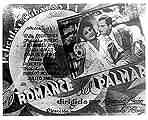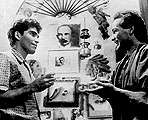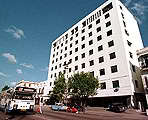|
The first Cuban film was made
in 1897, later on, during the Republican period, more than
eighty fiction movies were filmed, but it was not until
the revolution triumphed that the basis for a cinematographic
industry were set to develop the national cinema. In 1959
the Cuban Institute of Cinematographic Art and Industry
(ICAIC) was founded, this was essential for the moving-image
makers. In 1960 the "Cuban Cine" magazine was founded, sponsored
by the ICAIC. This magazine promoted the creative and theoretic
actions in the film industry. In that same year Tomas Gutierrez
Alea presented his Histories of the Revolution, first fiction
film and Julio Garcia Espinosa his Cuba Dances. At this
first stage, called by the critics "the golden decade of
Cuban cinema", the most outstanding films shown were: Death
of a Bureaucrat (1966) and Memories of Underdevelopment
(1968), both directed by Tomas Gutierrez Alea; Lucia (1968),
by Humberto Solas and The first carga al machete (1969),
by Manuel Octavio Gomez. Santiago Alvarez carried out an
exceptional work in documentary films, revealing his peculiar
gift throughout almost forty years of continued celluloid
creations. He directed important films such as, Cyclone
(1963), Hanoi, Tuesday 13th (1967) and 79 Springs (1969).
During the 70's the following films were made: The Last
Supper (1976) and Survivors (1978), by Tomas Gutierrez Alea;
You have the floor (1973), by Manuel Octavio Gomez; The
man from Maisinicu (1973), by Manuel Perez; In a certain
way (1974), by Sara Gomez; El Brigadista (1976), by Octavio
Cortazar; Teresa's portrait (1979), by Pastor Vega and November
Day (1972) by Humberto Solas. The 80ies were years of restating.
During this period there was a will of considering and restating
problems that spread to all forms of art. From this decade
are great films like: Secondary roles (1989) and Clandestine
(1987), by Orlando Rojas; The beauty of the Alhambra (1989),
by Enrique Pineda Barnet; Cecilia (1981) and A successful
man (1985), by Humberto Solas; A girlfriend for David (1987),
by Fernando Perez and Plaff (1989), by Juan Carlos Tabio.
The full-length animated film Vampires in Havana (1985),
directed by Frank Padron, was a celebrated success. The
nineties came with such noteworthy titles as: Hello Hemingway
(1990), by Fernando Perez; Alice in Wonder town (1990),
by Daniel Diaz Torres, Maria Antonia (1990), Sergio Giral;
The century of lights (1992), by Humberto Solas; Lovely
lies (1991), by Gerardo Chijona; Strawberry and Chocolate
(1993), produced by Tomas Gutierrez Alea and Juan Carlos
Tavio written by Senal Paz; The wave (1996), by Enrique
Alvarez; Put your thought on me (1993) and Upright love
(1996), by Arturo Soto. The most successful film in Cuba's
movie history is Strawberry and Chocolate, which was nominated
for an Oscar for best foreign film and introduced Cuba to
the world film market. Most recent Cuban films are Life
is to Whistle, by Fernando Perez, this was awarded the first
prize at the Latin American Film Festival in Havana. The
latest creation (2000) is Lista De Espera or Waiting List,
which is a light comedy about Cuban life set entirely in
a provincial bus station. Many of the films mentioned here
were awarded different prizes, throughout these decades
in national and international festivals.
For reservations and accreditation
purchases for Cuba's national film festival use Cuba's official
Cinema website is www.cinecubano.com
|



|









































